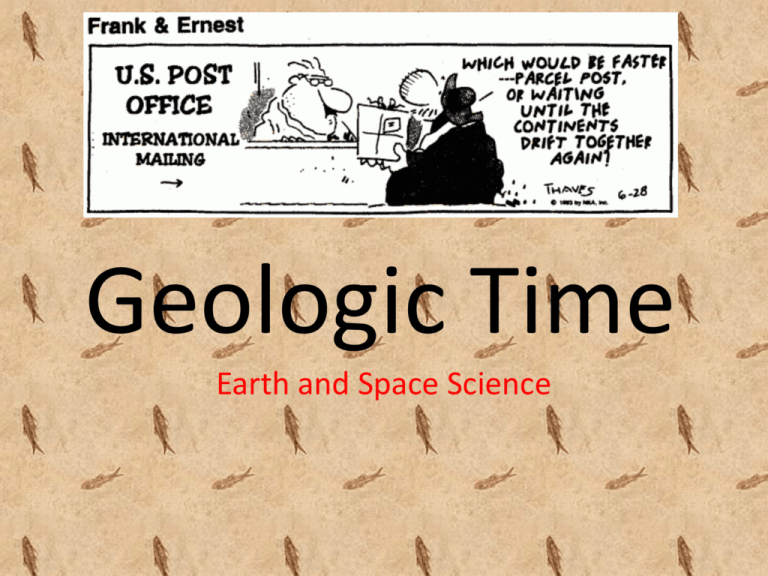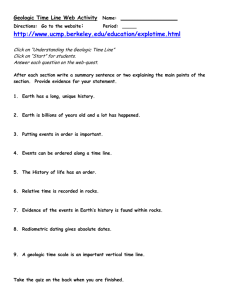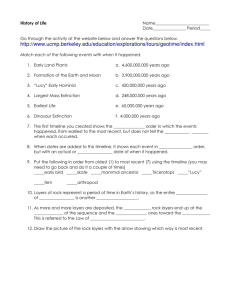Geologic Time
advertisement

Geologic Time Earth and Space Science Major Questions? How old is the Earth? How did it form? Was it created? Did it evolve? What processes were involved? What conditions and circumstances existed? • All these questions cannot be directly observed and therefore not directly tested through experimentation. • Some experimental methods exist that attempt to answer these questions, but how reliable are these methods? • There is certainly debate on this issue. Theories and Principles in Geology • There have been multiple theories to explain the age of the Earth, and several governing principles that geologists use to help interpret rocks, rock layers, fossils, and other geologic events. 1. Catastrophism • Archbishop James Ussher in the 17th century (1654) studied Biblical and other Middle Eastern records, and geneological accounts to estimate the Earth to be about 6000 years old. • This theory states that major changes to Earth’s surface are due to catastrophic events on Earth. For example: Noah’s worldwide flood Volcanic eruptions Earthquakes 2. Nicholas Steno (1669) • Steno described three fundamental principles used to help relative dating processing. 1. Superposition 2. Original horizontality 3. Lateral continuity *These three principles are still used and have had others added as information has been gathered. 3. Neptunists – 18th Century • This theory states that the entire globe was originally covered by water. • As the water receded sediments were deposited into layers, and rocks crystallized out from the water. • Proposed an Ancient Earth 4. Plutonists • As an offshoot of the Neptunists, the Plutonists believed that the rocks crystallized from molten magma as it cooled, not from the evaporating water. • Both groups unsure as to where the water went from the covered Earth. • Continued thought of Ancient Earth. 5. Gradualism – James Hutton (1795) • This Scottish geologist is often considered the “Father of modern geology.” • A Plutonist, he stated that the surface of the Ancient Earth is continuously and gradually changing. • Most of this change takes too long for us to witness during our own lifetime, but we see the accumulated effects of millions of years of change. 6. Faunal Succession – William Smith (1817) • He studied rocks in England. • Used similarities in key fossils to identify similar rock layers. • Use rock “fingerprinting” by finding distinct fossils in rock layers which are not found in the layers below or above. • This principle is used to determine relative age. 8. Uniformitarianism – Charles Lyell (1830) • Proposed that geologic processes have always acted with the same rate and intensity and in the same fashion as they do today. • The Laws of Nature have been relatively constant through the entire history of the Earth. • Does not eliminate catastrophic events as quick changes, just that they have always happened in the same manner. • “The present is the key to the past.” Geologic Time Scale • Geologists widely accept the theory that the Earth is about 4.5 billion years old • This time is divided up into Eons, Eras, Periods, and Epochs • See page 672 in your Glencoe book. Time Intervals • Eons are the largest division (billions of years) • There are four recognized eons based on evolutionary changes in fossilized life and rocks. Hadean, Archean, Proterozoic – these three are collectively called the Precambrian which dates back to the beginning of the Earth (>85% of the time) Phanerozoic eon – means “visible life” and contains the abundance of the fossil record. Time Intervals • Eras represent 100’s of millions of years • There are three main Eras 1. Paleozoic – “ancient life” 2. Mesozoic – “middle life” 3. Cenozoic – “recent life” Mass extinctions mark the end of one Era and the beginning of the next, with distinct fossils in each era. Time Intervals • Periods represent millions of years, and are named after an area in the world where rocks of that age were first located. • Examples include: Devonian, Triassic, Carboniferous, and Quaternary periods There are many distinct layers of rock thought to have formed during a specific period Time Intervals • Epochs are the shortest time division and are usually used to represent the last 66 million years or so of the Earth. • The Paleocene epoch begins with the mass extinction event of the dinosaurs. • We are currently in the Holocene epoch which began with the end of the most recent ice age. Dating • Scientists are always trying to figure out how old things are and what came first. Relative Age vs. Absolute Age • Relative age – a geologic order of events What came first? What layer is oldest? What is the sequence of oldest to youngest? Geologists use multiple rock layers to determine sequence. Relative Age vs. Absolute Age The problem is that some layers may be missing in some samples. Multiple samples must be used to fill in the blanks. Use distinctive fossils or rock layers, and deposits from multiple samples to determine the relative age of rocks and rock layers. Relative Age vs. Absolute Age • Absolute age – the actual age of a rock or a layers of rock Uses radiometric date as a primary testing method Measures radioactive materials with an experimentally tested and consistent half-life during the time tested. *There are concerns that this method is unreliable. Radiometric Dating • Unstable (radioactive) materials will spontaneously break down into more stable nuclei and emit particles and energy • This breakdown occurs with a specific measureable rate which scientists measure • Called the half-life, due to the time it takes for ½ of a sample to decay into another sample. Radiometric Dating • Scientists use the current percentages of radioactive materials found in nature and objects and the half-life to calculate in reverse how much time has gone by, back to when that material was formed Radiometric Dating • The most commonly used are: 1. Carbon-14 2. Potassium-Argon dating 3. Uranium-Lead dating Radiometric Dating • The accuracy of these methods has been called into question. • Several assumptions must be made for the dating techniques to be accurate. 1. All conditions in nature have been consistent with those we see today. 2. No contamination of the sample has occurred at any point in time 3. The decay rates been constant through billions of years of time. We cannot answer these three assumptions one way or the other.







